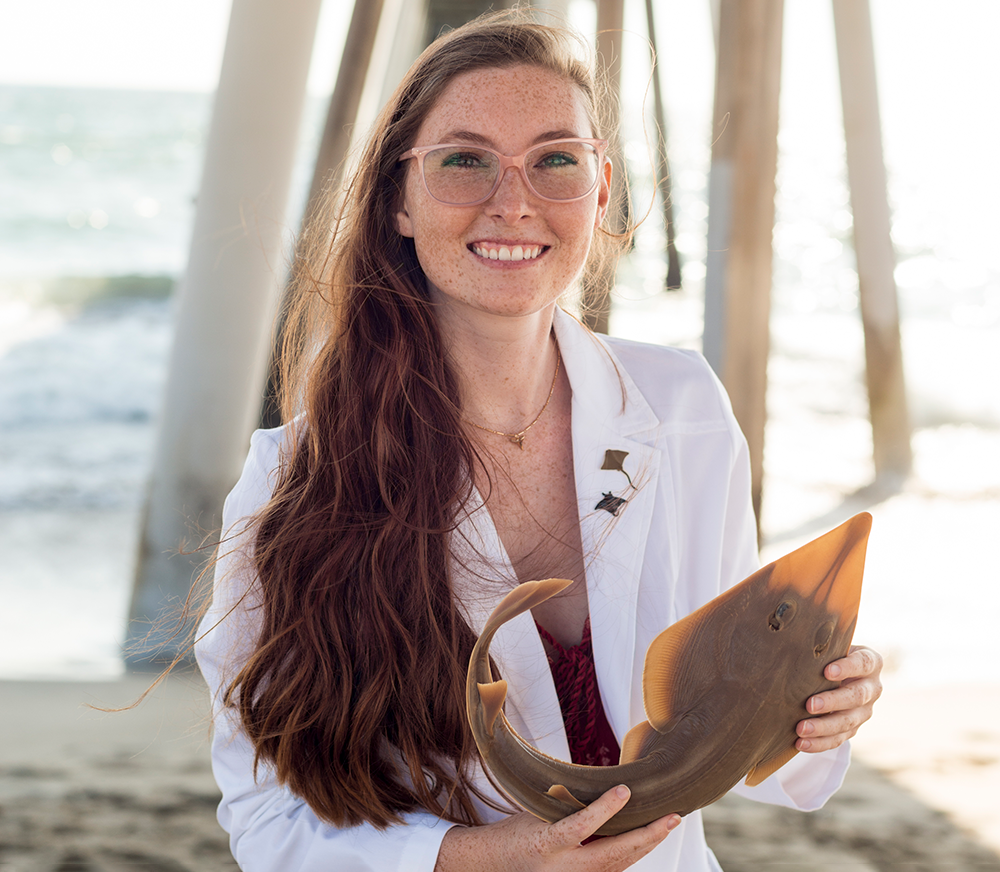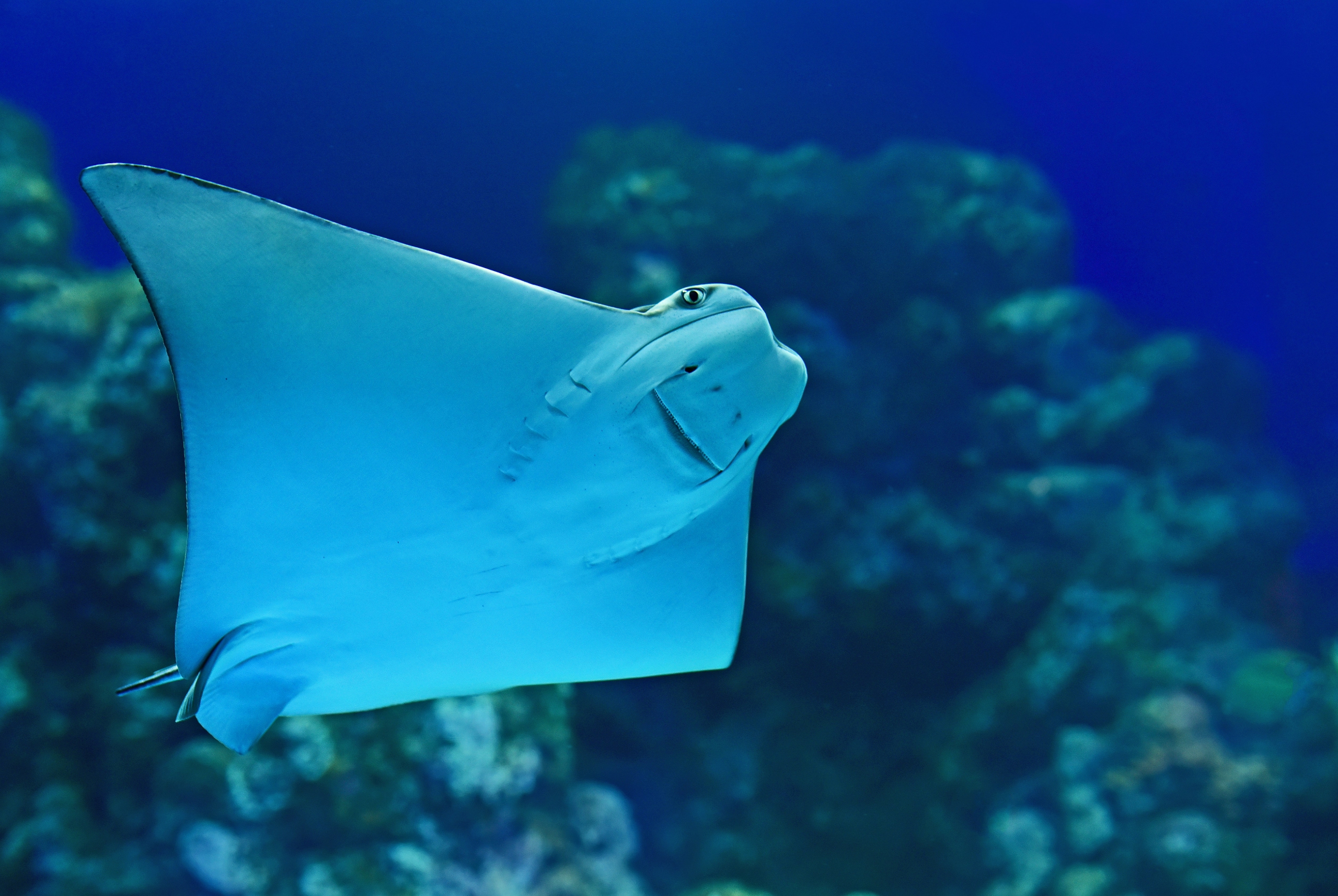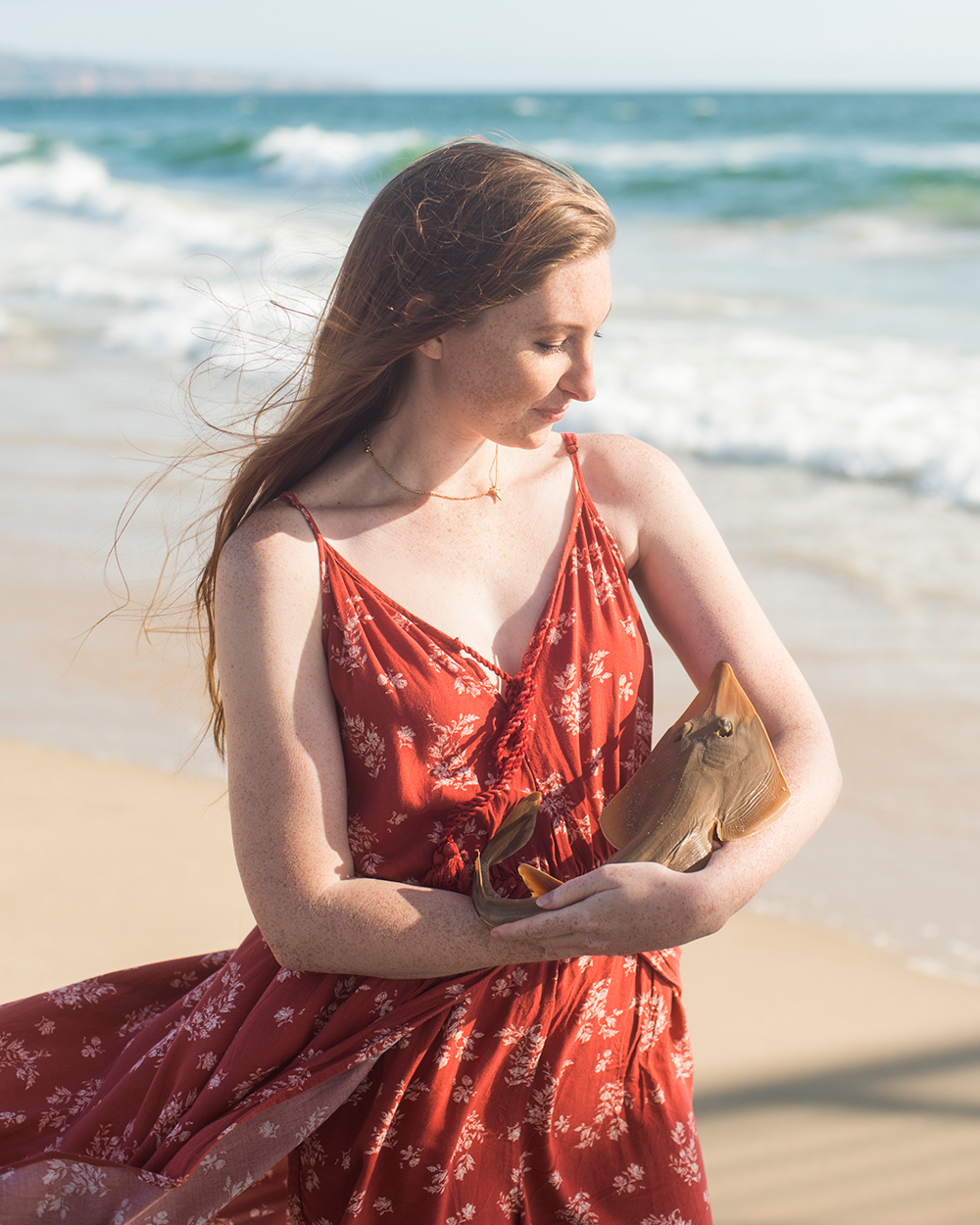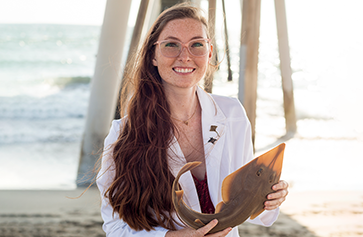The nature of innovation
Marine scientist Kelsi Rutledge explores new possibilities for bioinspired design

UC Grad Slam finalist Kelsi Rutledge holds a preserved museum specimen of Pseudobatos buthi, a new ray species she discovered.
Lucy Berbeo
Kelsi Rutledge wants you to understand the world from a fish’s perspective — a stingray’s, to be exact — and for good reason: this fascinating creature and its relatives may help lead the way to a more sustainable future.
Swimming the seas since prehistoric times, the ray is famed for its flat body, wing-like fins and venomous barb. But it has something else that the casual observer can’t see: a curiously shaped, powerful nose that can track a scent like a bloodhound. Rutledge, a doctoral student in the UCLA Department of Ecology and Evolutionary Biology, is shedding new light on this sensory superpower and what we can learn from it.
“There are all kinds of rays — huge, pelagic manta rays, deep-sea thorny skates, blind electric rays — and they all have different types of noses,” she says. “Some are circular, some are slit-like, others protrude from their heads. Why do they look so different, and how do they work? It’s not a simple question to answer. Unlike humans, their noses aren’t involved in breathing; they evolved only for smell. Without a pump-like system to bring odors in, how do their noses still smell so efficiently?”
Rooted in these questions, Rutledge’s research earned her a spot as a finalist in this year’s statewide UC Grad Slam competition. She’s interested in how the rays’ sniffers may influence bioinspired design, where technical innovations take a cue from nature’s systems and processes. Her findings are already being used by U.S. Navy engineers to improve underwater technology.

Rutledge’s research journey started at L.A.’s Natural History Museum — where, she says, scientists can check out animals “like books.” After borrowing a number of ray specimens, she worked with staff at UCLA Radiology to CT-scan the fishes’ heads, including their noses of varying shapes and sizes, then used a 3D printer to construct anatomically accurate models. Back at the lab, she used powerful lasers to illuminate water movement and compare the noses in action.
“We tracked individual water parcels to find out how the different nose shapes harnessed odors, which was fastest and most effective, and then tied that back to their ecology,” she says. “We wanted to understand why they evolved this system: do some species rely on sense of smell more than others? For example, deep-sea fishes with limited vision might need an odor-harnessing system that’s quicker and more efficient.”
“Through thousands of years of evolution, nature often provides innovative solutions to complex problems. If we can try to mimic what animals do so elegantly, we have the opportunity to advance our own technology.”
Learning to imitate the rays’ evolutionary “design” may be a game-changer in the era of climate change. Odors are chemicals, and monitoring chemical content in the ocean is vital in tracking the health of our seas, which provide nearly three-quarters of our oxygen. Chemicals like phosphorous, silicate and nitrogen also form the basis of the ocean’s food web, giving nutrients to phytoplankton and algae. And while current chemical detection methods are expensive and tech-heavy, the form and function of ray noses may inspire simple, energy-conscious solutions.
“There’s so much we can learn from animals. I have another paper that looked at the crushing power of stingray jaws — they can actually crush material that’s harder than their own skeleton,” Rutledge says. “Through thousands of years of evolution, nature often provides innovative solutions to complex problems. If we can try to mimic what animals do so elegantly, we have the opportunity to advance our own technology.”
Rutledge has long been curious about nature’s hidden, yet complex and fascinating worlds. Growing up in the mountains of North Carolina, she was drawn to ocean life and to the study of fishes in particular because of their incredible biodiversity, which led her down endless “research rabbit holes.” As a master’s student, she discovered a new species of guitarfish, a lesser-known and threatened ray relative. The news was covered by Forbes, Smithsonian Magazine and more — hardly typical in the old-school world of taxonomy.

Rutledge named the new species Pseudobatos buthi in honor of her supportive graduate advisor at UCLA, the late Don Buth.
“I staged a photoshoot with my professional photographer friend where I took silly photos with one of the museum specimens of my new species, similar in style to a birth announcement,” she shared on her website. “With a bit of apprehension, I then took to Twitter to post the photos. My hope was to engage scientists and non-scientists alike and highlight the importance of museum collections and this understudied and endangered group of fishes.”
After graduating, Rutledge will go on to Caltech’s Dabiri Lab to shine the spotlight on another odd but fascinating creature, the jellyfish — which, like the stingray, has managed to outlive the dinosaurs. “I’m really excited about this new project. Jellyfish are one of the most efficient swimmers in the ocean,” she says. “They’re so simple and complex at the same time.”
And in a field with endless possibilities, Rutledge continues to find wonder and inspiration in fishes, our strange evolutionary ancestors. “There’s so much we can learn about them,” she says. “There’s still so much to be discovered.”
Learn more about Kelsi Rutledge’s research and teaching at her website, fishandfreckles.com.
Related: How a UCLA fish scientist helped the alien in Jordan Peele’s ‘Nope’ seem terrifyingly real
For more of Our Stories at the College, click here.




